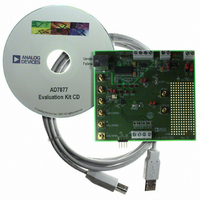EVAL-AD7877EBZ Analog Devices Inc, EVAL-AD7877EBZ Datasheet - Page 15

EVAL-AD7877EBZ
Manufacturer Part Number
EVAL-AD7877EBZ
Description
BOARD EVALUATION FOR AD7877
Manufacturer
Analog Devices Inc
Datasheets
1.AD7877ACBZ-REEL7.pdf
(44 pages)
2.EVAL-AD7877EBZ.pdf
(16 pages)
3.EVAL-AD7877EBZ.pdf
(44 pages)
Specifications of EVAL-AD7877EBZ
Main Purpose
Interface, Touch Screen Controller
Embedded
No
Utilized Ic / Part
AD7877
Primary Attributes
4-Wire Resistive Touch Screen Controller, SPI Interface, On-Chip: Temp Sensor, Voltage Reference, 8-Bit DAC
Secondary Attributes
USB GUI, LCD Noise Reduction Feature, 2.7 ~ 5.25 V, Wake Up on Touch Feature
Lead Free Status / RoHS Status
Lead free / RoHS Compliant
The AD7877 can be set up to automatically convert either
specific input channels or a sequence of channels. The results of
the ADC conversions are stored in the results registers. See the
Serial Interface section for details.
When measuring the ancillary analog inputs (AUX1 to AUX3,
BAT1 and BAT2), the ADC uses the internal reference, or an
external reference applied to the V
is referred to GND.
MEASURING TOUCH SCREEN INPUTS
When measuring the touch screen inputs, it is possible to
measure using the internal (or external) reference, or to use the
touch screen excitation voltage as the reference and perform a
ratiometric, differential measurement. The differential method
is the default and is selected by clearing the SER/ DFR bit
(Bit 11) in Control Register 1. The single-ended method is
selected by setting this bit.
Single-Ended Method
Figure 29 illustrates the single-ended method for the Y position.
For the X position, the excitation voltage is applied to X+ and
X− and the voltage measured at Y+.
AUX1/GPIO2
AUX2/GPIO3
AUX3/GPIO4
BAT1
BAT2
Figure 29. Single-Ended Conversion of Touch Screen Inputs
X+
Y+
X–
Y–
TEMPERATURE
V
SENSOR
CC
SCREEN
TOUCH
Figure 28. Analog Input Structure
GND
Y+
X+
Y–
V
9 TO 1
(VIA MUX)
MUX
CC
I/P
INPUT
REF
IN+
pin, and the measurement
V
X– Y– GND X+ Y+ V
ADC
REF
WITH TRACK-AND-HOLD
REF+
REF–
APPROXIMATION ADC
12-BIT SUCCESSIVE
DUAL 3-1
REF–
MUX
REF+
INT/EXT
REF
REF
Rev. C | Page 15 of 44
The voltage seen at the input to the ADC in Figure 29 is
The advantage of the single-ended method is that the touch
screen excitation voltage can be switched off once the signal is
acquired. Because a screen can draw over 1 mA, this is a
significant consideration for a battery-powered system.
The disadvantages of the single-ended method are as follows:
•
•
•
The single-ended method is adequate for applications that use a
fairly blunt and imprecise instrument for an input device, such
as a finger.
Ratiometric Method
The ratiometric method illustrated in Figure 30 shows the
negative input of the ADC reference tied to Y− and the positive
input connected to Y+. Thus, the screen excitation voltage
provides the reference for the ADC. The input of the ADC is
connected to X+ to determine the Y position.
It can be used only if V
than V
range of the ADC. If V
the ADC is not used.
The ratio of V
vary relative to one another, this can introduce errors.
Voltage drops across the switches can introduce errors.
Touch screens can have a total end-to-end resistance
ranging from 200 Ω to 900 Ω. Taking the lowest screen
resistance of 200 Ω and a typical switch resistance of 14 Ω
can reduce the apparent excitation voltage to 200/228 ×
100 = 87% of its actual value. In addition, the voltage drop
across the low-side switch adds to the ADC input voltage.
This introduces an offset into the input voltage, thus, it can
never reach zero.
V
IN
Figure 30. Ratiometric Conversion of Touch Screen Inputs
=
V
CC
REF
×
, some positions on the screen are outside the
R
YTOTAL
R
SCREEN
Y
TOUCH
CC
−
to V
GND
Y+
X+
Y–
REF
CC
CC
must be known. If V
is less than V
(VIA MUX)
is close to V
INPUT
V
CC
ADC
REF
REF
REF+
REF–
. If V
, the full range of
REF
CC
AD7877
is greater
and/or V
(1)
CC




















